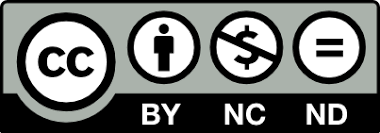Submissions
Submission Preparation Checklist
As part of the submission process, authors are required to check off their submission's compliance with all of the following items, and submissions may be returned to authors that do not adhere to these guidelines.- The submission has not been previously published, nor is it waiting review in another journal for consideration (or an explanation has been provided in Comments to the Editor).
- The submission file is in OpenOffice, Microsoft Word, RTF, or WordPerfect format.
- The text adheres to the stylistic and bibliographic requirements outlined in the Author Guidelines, which appear in the Submissions section.
- The authors comply with what is defined in the Code of Ethics section of the journal publication.
-
The manuscript contains the document received by the institutional Ethics Committee (if applicable), following this model:
“This article exposes the results of the research [name of the research] endorsed by the Ethics Committee of [institution], on [date], with approval code [#]. The authors agree to follw the international, national and institutional guidelines and requirements for studies performed on humans.
The Journal and the Association also request the Informed Consent for Case Reports and the Ethics Committee approval document.
- The authors undertake to send by this way, all the documentation and files defined in the guide for authors (affiliation sheet, letter to the editor or cover letter).
- Decimal numbers in the text, tables and figures are marked with commas and not points.
Original article
Original research papers on any of the areas of interest of the Journal will be considered as such. As a general rule, each section of the manuscript should begin on a new page and be structured as follows:
- Title page, as detailed above, in a separate file.
- In the manuscript file:
- Title, abstract and Keywords (in Spanish and English), as detailed above. The abstract should be structured, separated by sections, as indicated above. Each of the sections into which the abstract is divided (Introduction, Material and Methods, Results and Conclusions) should be in bold and separated by a full stop.
- Introduction, reviewing the state of the art and including the work’s objectives and/or hypotheses.
- Material and Methods, with a description of the materials used and the techniques and/or research methods followed.
- Results, with a concise description of the data obtained.
- Discussion
- Conclusions, which include if applicable the fulfillment of the objectives and the confirmation or refutation of the hypotheses presented.
- Conflicts of interest of the authors in relation to the article or a statement that there are no conflicts of interest.
- Acknowledgements, if any.
- Bibliographic references
In the case of clinical trials, the Revista de Psiquiatría Infanto-Juvenil adheres to the conditions defined by the Declaration of Helsinki and its subsequent amendments (https://bit.ly/3FtrBnP ), also developed in the Uniform Requirements for Manuscripts Submitted to Biomedical Journals (http://www.icmje.org). For publication of clinical trials, these should be registered in a public registry, and the registration information (NCT or Eudra-CT registration number) should be included in the Methods section of the manuscript. If registration did not take place before the start of the trial, a copy of the protocol approval from the health authorities of the countries in which the experimental research is being conducted should be submitted.
Review article
These include papers resulting of a research where the results of published or unpublished research on an area of interest of the Journal are analyzed, systematized and integrated, in order to report on its progress and actual development. These will be characterized by a careful bibliographic review, and will preferably be systematic reviews.
As a general rule, each section of the manuscript should begin on a new page, and the manuscript should be structured as follows:
- Title page, as detailed above, in a separate file.
- In the manuscript file:
- Title, abstract and Keywords (in Spanish and English), as detailed above. The abstract should be structured, separated by sections, as indicated above. Each of the sections into which the abstract is divided (Introduction, Material and Methods, Results and Conclusions) should be in bold and separated by a full stop.
- Introduction, explaining the purpose of the work.
- Justification and/or Objectives of the Review.
- Methods of the search and bibliographic review.
- Result (the review itself)
- Conflicts of interest of the authors in relation to the article or a statement that there are no conflicts of interest.
- Acknowledgements, if any.
- References
Case reports
Originals with a limited sample size will be considered as such, or those that describe clinical cases that represent an important contribution to the knowledge of the disease, or that briefly review specific aspects of interest for the contents of the Journal. Works published as Case Reports will have a maximum length of 10 pages, and may contain one or two figures and/or tables and up to 10 bibliographic citations. They will be structured under the following sequence:
- Title Page, as detailed above in a separate file.
- In the manuscript document:
- Title, Summary and Keywords (in Spanish and English), as detailed above. The abstract should be structured, separated by sections, as indicated above. Each of the sections into which the abstract is divided (Introduction, Description of the case, Discussion and Conclusions) should be in bold and separated by a full stop. Maximum of 250 words.
- Introduction, to theoretically frame the case/cases to be described
- Description of the clinical case, or development of the comment.
- Discussion, including a bibliographic review of previously published related cases.
- Conclusions.
- Acknowledgments.
- Conflicts of interest and ethical compliance.
- References.
3. Informed consent, following the attached model. The journal, as well as the author, will have this consent form if required.
Letters to the Editor
This section will accept short communications and preliminary communications that, due to their characteristics, can be summarized in a brief text, as well as those comments and scientific criticisms in relation to papers published in the Journal. In this case, letters will be sent simultaneously and prior to their publication, to the authors, for possible response (in order to exercise their right to reply). Letters should not exceed 750 words, the number of bibliographic citations should not exceed 10, and, if necessary, a figure or a table will be admitted.
Clinical Perspective
This section is intended to emphasize practical issues within Child and Adolescent Psychiatry from a clinical point of view. It could contain, for example, commentaries about problems of interest in clinical practice, controversies, comments to previous articles or any topic related to the practice of Child and Adolescent Psychiatry specialty, including the opinion of the authors. Manuscripts submitted to this section should be brief, not exceeding 1.000 words and with a maximum of 10 references.
Bibliographic Notes
This section will include comments on works relevant to the areas of interest of the Journal. Bibliographical notes will be made at the invitation of the Editorial Committee to experts in the field of interest.
Agenda
This section may contain notes on matters of general interest, congresses, courses and other activities considered important for the Journal's readers.
Monographic Issues
AEPNYA members or the Editorial Committee may propose the preparation of monographic issues, studying their characteristics together with the authors. Contributions to monographic issues will be submitted to peer review. Monographic issues may be considered extra or supplementary issues to the regular quarterly issues.
Privacy Statement
Privacy Policy
Through this website no personal data of users are collected without their knowledge, nor are they transferred to third parties.
The website owned by AEPNYA contains links to third party websites, whose privacy policies are unrelated to that of AEPNYA. By accessing such websites you can decide whether to accept their privacy and cookie policies. In general, if you browse the Internet you can accept or reject third party cookies from the configuration options of your browser.
Basic information on data protection
Information about the data protection policy of the Spanish Association of Child and Adolescent Psychiatry (Asociación Española de Psiquiatría del Niño y del Adolescente - AEPNYA) is shown below.
Responsibility for the data processing
All personal data that may be collected directly from the authors will be treated confidentially and will be incorporated into the corresponding data processing activity owned by the Asociación Española de Psiquiatría del Niño y del Adolescente (AEPNYA).
Purpose
The purpose of the treatment of the data obtained through the contact form is exclusively the management of the information requested.
Legitimation
Legitimacy for the processing of data used for sending an article and data obtained through the contact form is based on the express consent of the owner of the data.
The names and email addresses entered in this journal site will be used exclusively for the stated purposes of this journal and will not be made available for any other purpose or to any other party.




 © 2021 AEPNyA Todos los derechos reservados
© 2021 AEPNyA Todos los derechos reservados
